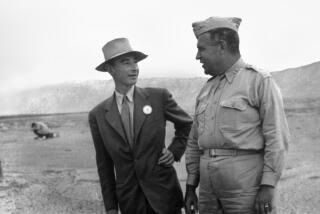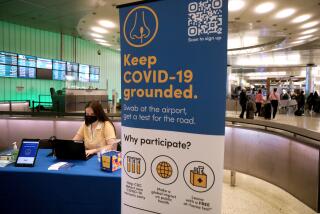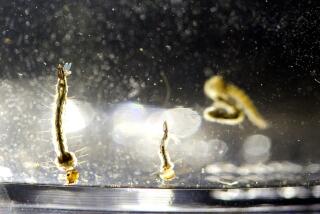Disarming Biological Weapons
LIVERMORE — Behind barbed wire and guarded gates, in spartan buildings identified by numbers, researchers at Lawrence Livermore National Laboratory are using expertise from nuclear weapons work to hone the nation’s defenses for the new war against terrorism.
In several months, officials say firefighters, police and other emergency workers should be able to respond to the scene of a possible biological attack with a hand-held mini-DNA lab developed here. Within half an hour, they would know whether anthrax bacteria or diseases such as plague are present.
If a dangerous substance is detected, emergency workers could blanket it with a special gel developed by Lawrence researchers to kill biological agents and neutralize chemicals without harming people.
Further down the road, scientists plan to deploy a second device that could constantly monitor and analyze the air in a convention hall, subway or even an entire city--and send out an alarm if pathogens reach a trigger level. Already, following the Sept. 11 attacks, Lawrence officials have installed a less advanced system of biocollectors in one undisclosed city.
Lawrence Livermore, a low-rise complex rambling across this East Bay suburb of tract homes, malls and rolling grasslands, was at the fountainhead of the Cold War. Researchers here played key roles in building the nation’s nuclear arsenal.
But for several years in the wake of the Cold War, the lab has quietly pursued counter-terrorism research. Now that mission has taken on added urgency and importance.
The chemical and biological warfare research at Livermore offers a glimpse of the government’s efforts to build future defenses against what some call “the poor man’s atomic bomb.” It also shows how one of the nation’s most prominent nuclear weapons facilities has positioned itself to help wage a costly struggle against terrorism that Defense Secretary Donald Rumsfeld says could last as long as the Cold War.
Concerns about the country’s biological weapons preparedness escalated after the 1991 Persian Gulf War when United Nations inspectors found that Iraq’s biological arsenal included anthrax and other agents. The U.S. had no way to perform prompt field detection and identification of deadly biological agents to protect military personnel, let alone civilians back home.
‘An Increased Sense of Urgency’
Detection often remains painfully slow. When aides to Senate Majority Leader Tom Daschle reported last week that their office had received an envelope containing a suspicious powder, it took much of the day to determine that the substance contained anthrax spores.
To address such shortcomings, Congress in 1996 authorized the Energy Department to establish programs to counter domestic terrorism. And Lawrence was one of the labs that expanded its bio-defense work.
“Since Sept. 11, things have changed dramatically,” said Page Stoutland, the lab’s deputy division leader for counter-biological terrorism. “We feel an increased sense of urgency, so we are doing everything we possibly can to accelerate development of detectors and our other work.”
Lawrence, run by the University of California for the U.S. Department of Energy, still spends most of its budget on its nuclear missions. The lab devoted about $14 million last year to chemical and biological national security work--about 1% of its $1.3-billion budget.
“It’s obviously not enough,” said Michael O’Hanlon, a senior analyst at the Brookings Institution. “Counter-terrorism work has the real potential for being one of the four or five key themes for research” by Lawrence and other national labs in the post-Cold War era.
Lawrence officials acknowledge that they might have developed anti-terrorism devices more rapidly if they had more money.
The Energy Department’s proposed budget for the 2002 fiscal year originally called for cutting the nationwide budget for chemical and biological national security by about 30%. But lab officials say they are hopeful that they will now get a portion of a $63-million budget request from the department’s National Nuclear Security Agency made after the attacks on the Pentagon and the World Trade Center.
Many counter-terrorism projects here flow from Lawrence’s nuclear research, including the study of fallout patterns and radiation’s effects on the human body, said Wayne Shotts, associate director of nuclear nonproliferation, arms control and international security.
The starting point was an effort by Lawrence and other government-funded laboratories to identify fingerprint-like genetic signatures for the most likely biological weapons. For security reasons, officials decline to identify all substances being studied but confirm that they include plague and anthrax.
The portable, battery-powered Hand-Held Advanced Nucleic Acid Analyzer, which measures about 10 inches long and 4 inches wide, is one outgrowth of that research.
The device is configured to analyze several samples on the scene within 30 minutes--a fraction of the time laboratory analysis normally takes. The samples are placed in tiny test tubes, then subjected to a DNA analysis.
Corporations Willing to ‘Spend What It Takes’
Smiths Group Protection and Detection Systems, based outside Baltimore, has acquired the right to manufacture and distribute the device, providing royalties to the university.
Originally, the target date for commercial sale was mid-2002. Now, the schedule has been pushed forward, and the device should be in full production by April, said Sam Lucas, the company’s marketing and development director.
The company initially projected it would sell up to 2,000 units over three years. Only a relatively small number of local emergency response agencies thought they could afford an instrument that might cost $15,000 to $20,000 and be rarely deployed, Lucas said.
That attitude shifted after hijacked planes hit the Pentagon and World Trade Center. Inquiries quadrupled. Agencies started saying, “We’ll spend what it takes.”
So far, the device has limitations, said Bert Weinstein, the lab’s associate director of biology. Proper operation requires a fair amount of training, and it can test for only a limited number of potential biological warfare agents.
“These devices are still in their infancy,” said Ken Ewing, a senior research scientist at the Battelle Memorial Institute who analyzed commercial detection equipment for the U.S. Justice Department. “You’re not going to plop in a sample, push a button and then the machine will spit out the answer.”
A Smoke Detector That Sniffs Pathogens
Another device at Lawrence--the Autonomous Pathogen Detection System--is probably a year or two from production, officials say. The prototype--with an air intake and computer monitor atop a maze of wires, tubes and chemical tanks--sucks in air, then collects particles in a liquid for analysis. The results appear on a computer screen every 30 minutes. The device currently is coded to detect seven bacteria or viruses, but researchers hope to increase that to 25 to 50.
“It functions like a smoke detector,” said Richard Langlois, senior biomedical scientist. “But it gives alarms and could be set up in a convention hall or subway.
“You don’t know what a terrorist would use, and it may be colorless and tasteless,” said Langlois. “This [device] could give an early warning and save many lives.”
To protect a complex of buildings, or a city, a network of the devices could be linked to an emergency response center, researchers say.
Meantime, Lawrence has placed a non-automated detection system in an undisclosed major city following the recent attacks. The Biological Aerosol Sentry and Information System employs air collectors at multiple locations, but samples must be retrieved and brought to a mobile DNA lab for analysis.
Another challenge has been to find a substance that could decontaminate areas without harming people and the environment.
Lawrence scientists devised a spray that accomplished that in field testing by the Defense Department. The active ingredient is peroxymonosulfate--a substance used in some denture cleaners that is about as caustic as vinegar. But researchers say it kills biological agents and neutralizes chemical ones.
When transported, the silica-based substance is in gel form and is unlikely to spill. When stirred, the gel becomes a liquid. When sprayed, the substance turns back into a gel that can adhere to walls, ceilings and other surfaces. After it dries, the powdery residue can be vacuumed or steam-cleaned, or simply left in place.
The gel could be applied from the air over large areas, such as a stadium, or sprayed by hand in subways and buildings.
“The hazardous materials team would go into the contaminated area . . . and spray the area that was visually contaminated right away,” said Ellen Raber, head of Lawrence’s environmental protection department, describing how the gel would work. Within 30 to 40 minutes, the area would be decontaminated, and within four hours, the gel would be dry, she said.
Scientists also have been conducting drills that predict how plumes of airborne chemical or biological agents would travel through major U.S. cities.
Predicting the Path of Airborne Fallout
Lawrence has applied the technology to predict fallout paths from the nuclear accidents at Three Mile Island in 1979 and Chernobyl in 1986, and the Kuwaiti oil field fires in 1991. More recently, the lab helped California health workers by plotting the course of smoke from major tire fires.
The computer model can be programmed to assess terrorist releases worldwide, from the Grand Canyon to urban “street canyons,” whether they involve explosion, fire or even crop dusters.
“We can do a scenario at any altitude and any release rate,” said Jim Ellis, head of the National Atmospheric Release Advisory Center.
The model already has been used, Ellis said, to plan evacuation routes for heads of state attending major events.
Such new uses of nuclear-related technologies were envisioned long ago, said Shotts. “The lab . . . early on recognized that the science and technology it supported could also be important to other national missions [such as] terrorism,” he said.
*
Times staff writer Stephanie Simon in St. Louis contributed to this article.
More to Read
Sign up for Essential California
The most important California stories and recommendations in your inbox every morning.
You may occasionally receive promotional content from the Los Angeles Times.










